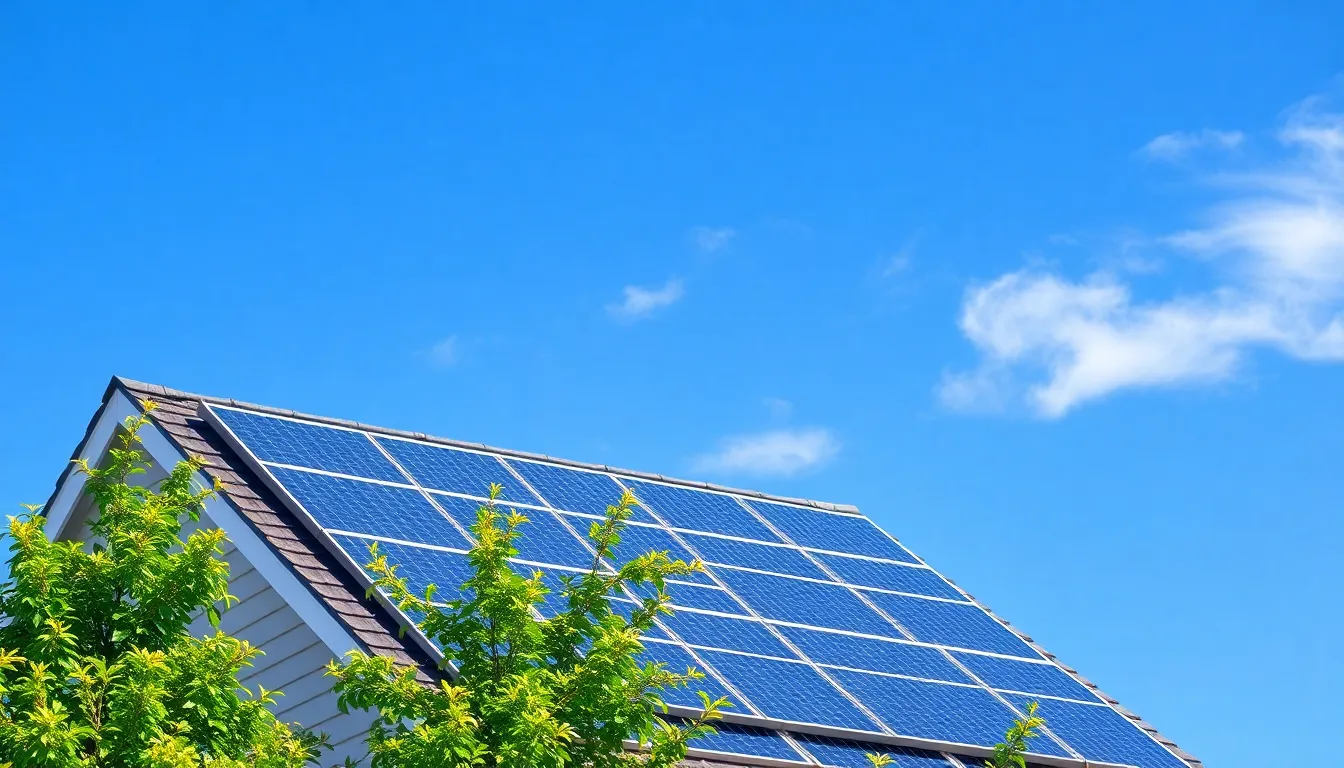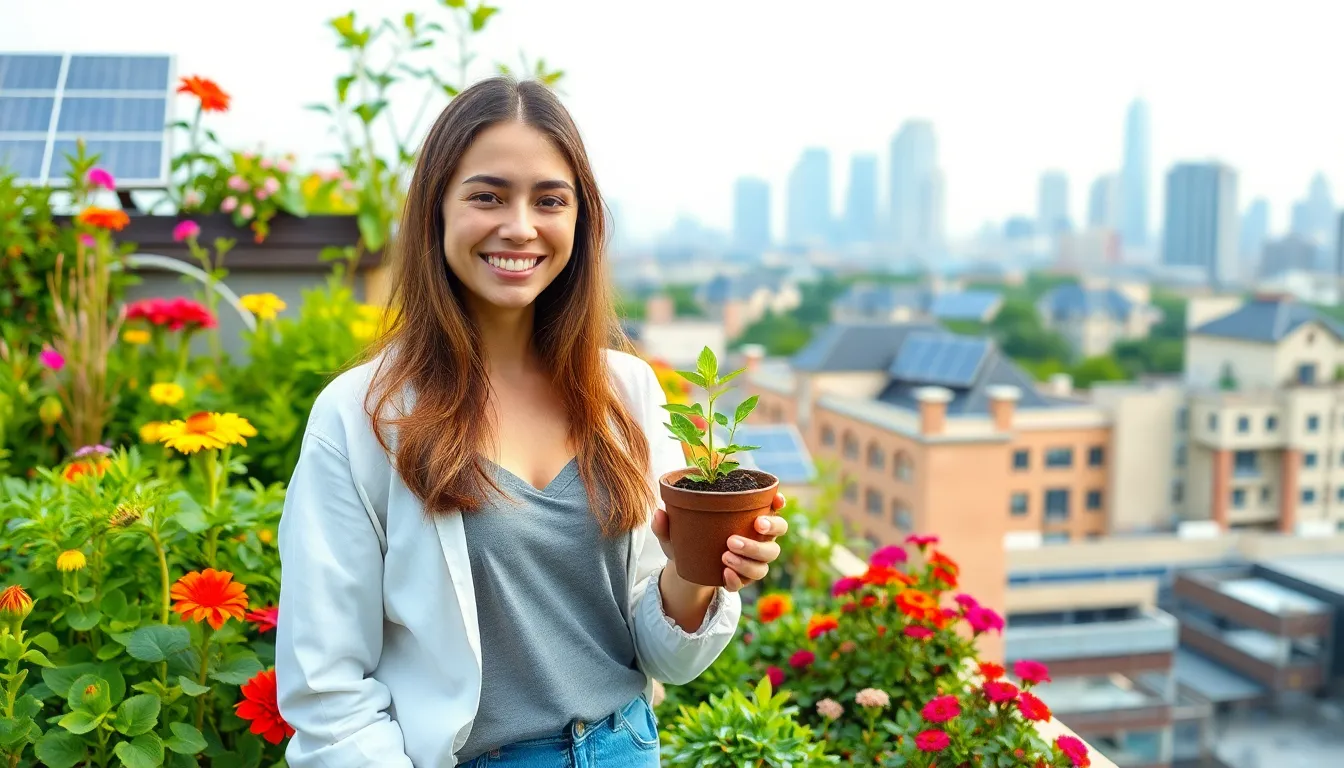In a world where plastic bags seem to multiply like rabbits and energy bills resemble a small mortgage, sustainable living innovations are stepping in like superheroes in eco-friendly capes. These groundbreaking ideas aren’t just saving the planet; they’re making life a whole lot cooler. Imagine a home that runs on sunshine, or a garden that thrives on recycled water—sounds like science fiction, right? Well, it’s not!
As society embraces the green revolution, innovative solutions are popping up faster than you can say “compost bin.” From smart appliances that cut energy use to urban farming techniques that turn concrete jungles into lush oases, sustainable living is becoming a lifestyle choice that’s both trendy and necessary. Buckle up as we dive into the fascinating world of eco-innovations that not only promise a brighter future but might just make you the coolest kid on the block.
Table of Contents
ToggleOverview of Sustainable Living Innovations
Sustainable living innovations encompass a variety of solutions that promote environmental responsibility. From energy-efficient homes powered by solar panels to water-conserving gardens that utilize recycled water, these innovations reshape daily life. Smart appliances represent another key component, enhancing energy efficiency while simplifying household tasks. Urban farming techniques, including vertical gardens and rooftop farms, maximize space and yield fresh produce in city environments.
Innovative materials play a crucial role in sustainable architecture. Biodegradable and recycled materials reduce waste and minimize the carbon footprint of construction projects. Electric vehicles are gaining traction as a sustainable alternative to traditional gas-powered cars, fostering reduced greenhouse gas emissions. Additionally, community initiatives, such as composting programs, encourage resource recovery and promote local food systems.
Sustainable fashion reflects growing awareness of environmental impacts within the apparel industry. Brands now prioritize eco-friendly materials and ethical production methods, allowing consumers to make conscious choices. Advances in technology also contribute to sustainability; for example, apps that track energy usage empower individuals to manage resources effectively.
Education on sustainability raises awareness about the importance of these innovations. Workshops and online courses help individuals understand their impact and adopt more eco-friendly practices. As these innovations proliferate, they provide both environmental and lifestyle benefits, making sustainable living attainable for everyone. Sustainable living has become not just an aspirational goal but a practical approach that individuals can easily integrate into their everyday lives.
Renewable Energy Solutions

Renewable energy solutions play a crucial role in sustainable living. These innovations provide clean power options that significantly reduce carbon footprints.
Solar Power Advancements
Recent advancements in solar power technology enhance energy efficiency and affordability. High-efficiency solar panels now convert over 22% of sunlight into electricity. Innovations like photovoltaic cells integrated into building materials streamline installation and enhance aesthetics. Additionally, solar batteries enable energy storage, allowing homes to utilize solar energy even after sunset. Many homeowners benefit from government incentives, making solar adoption financially viable. Solar power contributes to reducing reliance on fossil fuels while providing substantial long-term savings.
Wind Energy Developments
Wind energy developments offer a powerful alternative to traditional energy sources. The latest wind turbines reach capacities of 10 megawatts, generating substantial power for entire communities. Offshore wind farms benefit from strong, consistent winds, positioning them as a key player in renewable energy. Additionally, technological innovations in turbine design improve efficiency and reduce maintenance costs. Many countries invest in wind energy, recognizing its potential to contribute significantly to energy needs. Countries like Denmark generate over 40% of their electricity from wind energy, showcasing its viability on a national scale.
Sustainable Agriculture Practices
Sustainable agriculture practices focus on enhancing food production while minimizing environmental impact. Innovations in this field support eco-friendly farming methods aimed at long-term viability.
Vertical Farming
Vertical farming utilizes stacked layers to grow crops, allowing for higher yields in smaller spaces. This method requires less land and water compared to traditional farming. Additionally, vertical farms can integrate advanced technologies such as LED lighting and hydroponics, reducing pesticide use. Notably, cities benefit from this practice as it allows local food production, lowering transportation costs and emissions. Farms like Brooklyn Grange demonstrate the success of vertical farms, producing significant amounts of fresh produce for urban communities.
Aquaponics Systems
Aquaponics systems combine aquaculture and hydroponics to create a symbiotic environment. In this method, fish waste provides nutrients for plants, which in turn filter and clean the water for fish. This closed-loop system minimizes water usage, with studies showing it uses up to 90% less water than traditional farming techniques. Farms leveraging aquaponics, such as a commercial system in New York, showcase the ability to produce fish and vegetables together sustainably. Furthermore, aquaponics systems can lead to improved nutrient retention and faster growth rates, making it a promising solution for sustainable agriculture.
Eco-Friendly Transportation Options
Sustainable transportation options emerge as a vital aspect of eco-friendly living. These innovations focus on reducing carbon footprints while enhancing mobility choices.
Electric Vehicles
Electric vehicles (EVs) gain popularity as a cleaner alternative to gas-powered cars. They run on electricity, resulting in zero tailpipe emissions and lower greenhouse gas output. Current models include sedans, SUVs, and trucks, all offering impressive ranges and performance efficiency. Brands such as Tesla and Nissan lead the market, providing models that combine style with sustainability. Charging infrastructure expands rapidly, making it easier for drivers to recharge their vehicles. Incentives such as tax credits further encourage the transition to electric mobility.
Bike-Sharing Programs
Bike-sharing programs enhance urban transportation by promoting alternative, eco-friendly commuting methods. Cities implement these systems to allow residents to rent bikes for short trips, reducing traffic congestion and pollution. For instance, programs like Citi Bike in New York City and Divvy in Chicago offer convenient access to bicycles in various locations. Accessible stations make picking up and returning bikes straightforward. These initiatives also encourage physical activity and contribute to a vibrant community atmosphere. By providing a flexible and affordable transportation option, bike-sharing programs support cleaner urban environments and healthier lifestyles.
Water Conservation Technologies
Water conservation technologies play a vital role in sustainable living by optimizing water usage and minimizing waste. These innovations significantly support environmental and lifestyle benefits.
Rainwater Harvesting
Rainwater harvesting systems collect and store rainwater for later use. Homeowners can install barrels beneath gutters to capture runoff. Collected water finds applications in irrigation, toilet flushing, and even washing clothes. Systems vary in complexity from simple barrels to advanced setups with filtration and treatment processes. In regions facing water scarcity, using harvested rainwater reduces reliance on traditional water sources.
Greywater Recycling
Greywater recycling systems treat wastewater from sinks, showers, and washing machines for reuse. This approach diverts water from sewers while conserving fresh water. Systems typically involve filtration and may include biological treatment to ensure safety. Reused greywater supports landscape irrigation and toilet flushing, substantially decreasing overall water consumption. Many households report significant savings on water bills after implementing greywater recycling methods.
Sustainable living innovations are reshaping how individuals interact with their environment. By embracing these advancements, people can significantly reduce their carbon footprints while enhancing their quality of life. From energy-efficient homes to urban farming techniques, each innovation plays a vital role in fostering a greener future.
As awareness of environmental issues grows, the adoption of eco-friendly practices becomes more accessible. Communities are stepping up with initiatives that encourage responsible consumption and resource management. The shift toward sustainability is not just a trend; it’s a necessary evolution toward a healthier planet.
With ongoing advancements in technology and a commitment to education, the path to sustainable living is clearer than ever. Each small change contributes to a larger movement that benefits both individuals and the environment.



